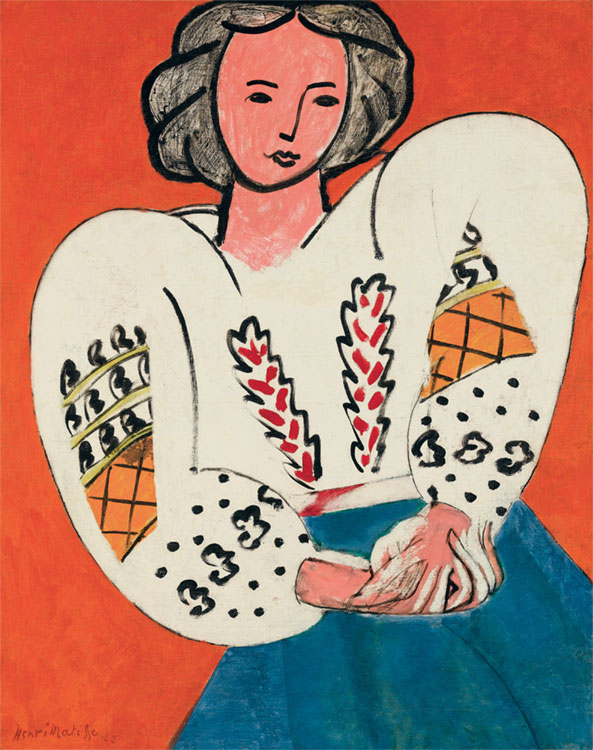Posted on October 27, 2020 in Arts & culture.
Matisse, like a novel - Until February 22, 2021 at the Center Pompidou
On the occasion of the one hundred and fiftieth anniversary of the birth of Henri Matisse (1869-1954), the Center Pompidou pays tribute to him through the exhibition “Matisse, comme un roman”, rich in more than 230 works and 70 documents and archives.

Henri Matisse, La Blouse roumaine, 1940 Oil on canvas, 92 × 73 cm Center Pompidou, Musée national d'art moderne, Paris Gift of the artist to the State, 1953 Attribution, 1953 © Succession H. Matisse Photo © Center Pompidou , Mnam-Cci / Georges Meguerditchian / Dist. Rmn-Gp
"The importance of an artist is measured by the quantity of new signs that he will have introduced into visual language", declared Matisse. Throughout his life, he was this decisive innovator.
A chronological journey in nine chapters traces the beginnings of the young artist, late in painting in the 1890s, until the complete liberation of line and color with the cut-out gouaches produced at the end of his life.
The exhibition displays for the first time around a hundred works from the collection of the Musée national d'art moderne, one of the most significant in terms of its importance, representative of all the techniques tirelessly studied by Matisse.
For this event in the form of a celebration, the Center Pompidou's collection is enhanced with remarkable loans granted by French museums: the two Matisse museums, at CateauCambrésis and in Nice, as well as the rich Matisse collection of the Grenoble museum, including the Interior aux aubergines (1911), is moved for the exhibition in an exceptional way.
This gathering of key works from major French and international collections, public and private, illustrates Matisse's trajectory over more than five decades during which key pages of modern art were written.
Replaying the title of Louis Aragon's work, Henri Matisse, roman (1971), the exhibition “Matisse, comme un roman” takes up its principle of walking through the work, seeking, as in the book, to capture “a glow on what is happening ”. Each of the nine sequences in the exhibition is illuminated by the gaze of an author focused on the Matissian work: Louis Aragon, Georges Duthuit, Dominique Fourcade, Clement Greenberg, Charles Lewis Hind, Pierre Schneider, Jean Clay and Henri Matisse himself. even. Echoing these writers, critics and poets, the exhibition questions Matisse's relationship to all writings - from the plastic sign to the word.
"Where to mark this beginning? ", asks Aragon in Henri Matisse, novel. From his beginnings in the 1890s, Matisse tried his hand at different practices. This painter, sculptor, draftsman, engraver wanted to find "a writing for each object". An artist of critical demand, anxious to shed light on his creative process during his life, in spite of himself, he gave birth to a writer Matisse. So, "Matisse explains Matisse" : "A fawn painting is a luminous block formed by the agreement of several colors, forming a possible space for the mind (in the genre, in my opinion, of that of a musical chord) […]". During the Fauve period (1905-1906), he ventured into a radical reformulation of color and drawing.
This authentic revolution of the gaze was reconfigured in the 1910s around a reflection on the decorative, of which one of the most masterful examples is the Interior with aubergines (1911), only of the "Symphonic interiors" to be kept in France. This new plastic writing does not, however, be fixed in a style: in the 1910s, the painter tried to test the various trends that crossed the artistic scene of his time - cubism, in particular, with Tête blanche et rose (1914). In 1917, his departure for Nice and the decade that followed abandoned the experimental dimension of an art that had almost reached the threshold of abstraction: the painter chose to return to a subject shaped by light.
The literary question in Matisse's work takes a new turn from the 1930s, when he focuses on the illustrated book with Mallarmé's Poésies, which resonate with certain iconic canvases from this period, such as Nymphe dans la forest (La Verdure) (1935-1943). In 1947, Matisse succeeded with Jazz in interweaving the plastic and the word, by designing cut-out gouaches and handwritten texts. The expansive character of color and black and white is reflected in the intimate dialogue between the “Vence Interiors” and the brush drawings. Finally, the colored stained-glass windows and ceramics in the chapel of Vence at the end of his life, still bear witness to an uninterrupted migration from work to writing in what Matisse saw as a large book open in space.
Pratical information
The exhibition
Matisse, like a novel
October 21, 2020 - February 22, 2021
Gallery 1, level 6
The Centre Pompidou
75191 Paris cedex 04 / T. 00 33 (0) 1 44 78 12 33
Metro: Hôtel de Ville, Rambuteau / RER Châtelet-Les-Halles
Wearing a mask is compulsory for visitors aged 11 and over.
Opening hours and prices
Exhibition open every day from 11 a.m. to 21 p.m.
€ 15, reduced price € 12 / Free for children under 18.
Mandatory reservation online at www.billetterie.centrepompidou.fr
The reservation of a time slot applies to all visitors including members and those benefiting from free admission.
Those under 26 *, teachers and students of art schools, as well as members of the Maison des Artistes benefit from free admission to the Museum and a reduced price ticket for exhibitions. Free access for Center Pompidou members.
* 18-25 years old nationals of a member state of the EU or another state party to the agreement on the European Economic Area. Valid the same day for the National Museum of Modern Art and all exhibitions.
Drawing Now Art Fair: Tatiana Wolska winner 2024
The invention of language by Gertrude Stein and Pablo Picasso
The history of French women's golf at Golf du Sorbier








